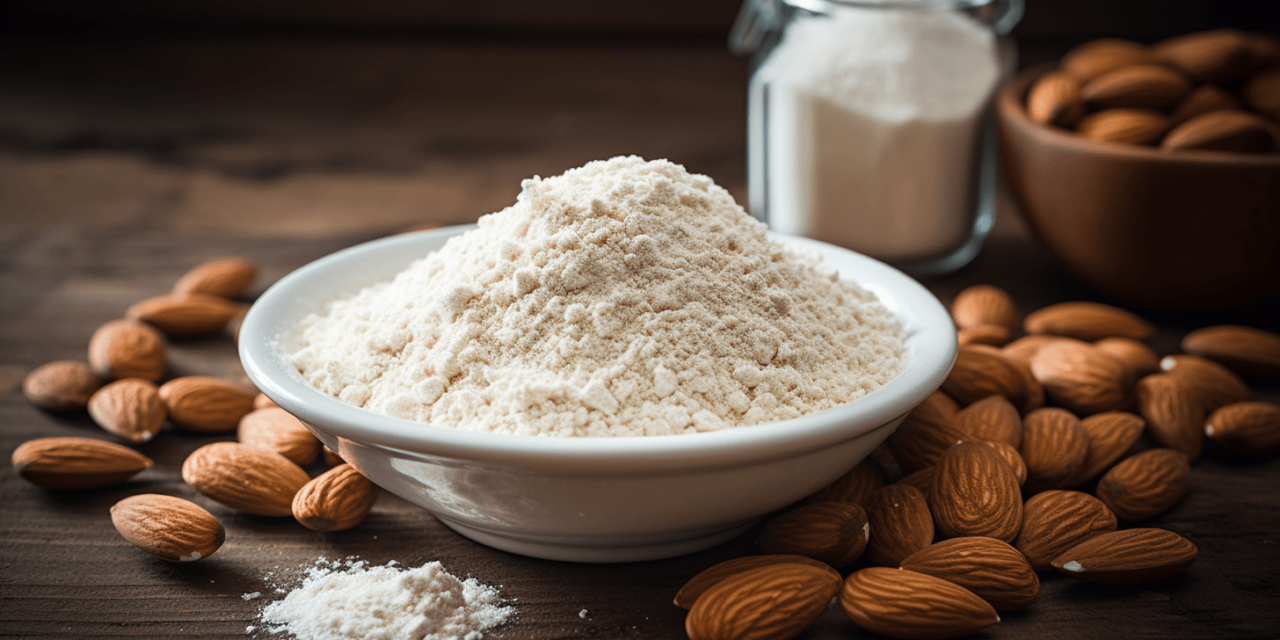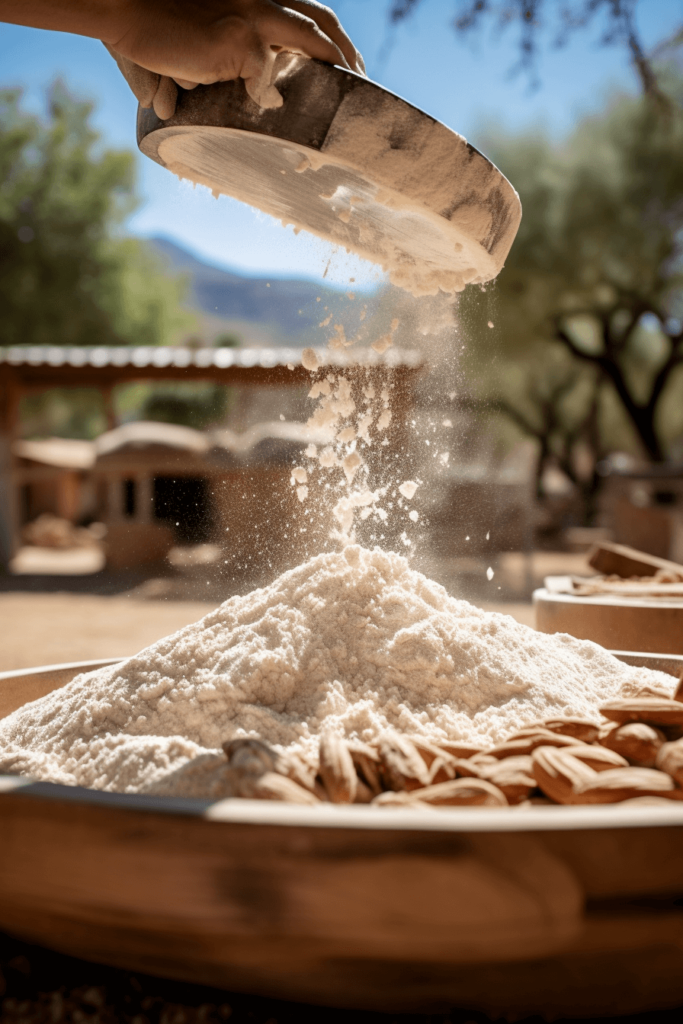Almond flour has become increasingly popular recently, particularly among people
looking for gluten-free and low-carb options in their cooking and baking endeavors. One
common question that arises is: Can you eat almond flour raw?
In this discussion, we will delve into the aspects of eating almond flour in its uncooked
state, exploring its uses, nutritional benefits, and considerations for incorporating it into
your diet.
Table of Contents
What is Almond Flour?
Almond flour is essentially ground almonds and serves as a widely embraced substitute
for conventional wheat flour, especially among those adhering to gluten-free or low-carb
eating habits. This flour boasts a distinct nutty taste and finely milled consistency and is
incredibly adaptable in various cooking scenarios.
Can You Eat Almond Flour Raw?
Yes, you can eat almond flour raw. Almond flour, derived from finely ground almonds, is
inherently safe to eat without cooking since raw almonds are edible. It’s common in raw
or no-bake recipes like energy bars, truffles, and specific desserts.
Consuming raw almond flour imparts a nutty taste with a slightly gritty texture. It’s
versatile, whether blended into smoothies, sprinkled on yogurt or oatmeal, or integrated
into raw cuisine.
How is Almond Flour Made?
Almond flour is made through a relatively straightforward process that involves
blanching, drying, and finely grinding almonds. Here are the key steps involved in
making almond flour:
Harvesting and Shelling:
Almond trees bear almonds harvested at their ripest stage.
These almonds are usually encased in a tough shell, necessitating removal to access
the edible kernel inside.
Blanching:
After shelling, almonds are usually blanched to remove the skins. This
process involves briefly immersing the almonds in boiling water, followed by cold water
to cool them down. The skins can then be easily peeled off.
Drying:
The blanched almonds are dried to reduce moisture content. Excess moisture
can affect the texture of the almond flour and lead to spoilage.
Grinding:
The subsequent step in the process involves grinding. After drying, almonds
are finely ground into a powder or flour-like consistency using specialized equipment
such as food processors or blenders.
The fineness of the grinding can vary, yielding different types of almond flour, including
blanched almond flour (with skin removed) and almond meal (with skins intact).
Nutritional Composition of Almond Flour
Almond Flour’s Nutritional Snapshot (per 2 tablespoons – 14 grams):
Calories:
79.9 calories – Almond flour is energy-rich due to its relatively high-fat content.
Protein:
3 grams – A moderate protein source, essential for muscle growth and overall
bodily functions.
Fat:
7 grams – Abundant in healthy fats, primarily heart-friendly monounsaturated fats.
Carbohydrates:
3 grams – A low-carb alternative to wheat flour, ideal for low-carb and
keto diets.
Dietary Fiber:
2 grams – Contains notable dietary fiber, supporting digestive health,
satiety, and weight management.
Magnesium:
Provides 10% of the recommended daily intake (RDA) – Essential for
muscle, nerve function, bone health, and energy production.
Vitamin E:
Provides 25% of the recommended daily intake (RDA) – Acts as an
antioxidant, shielding cells from free radical damage.
Saturated Fatty Acids:
Contains just 3% of the recommended daily intake (RDA) – The
majority of fat is heart-healthy monounsaturated.
Precautions When Consuming Raw Almond Flour
Enjoying raw almond flour is usually safe for most people, but it’s wise to consider a few
precautions:
Allergies:
If you have known allergies to almonds or tree nuts, avoid raw almond flour.
Quality:
Ensure the raw almond flour you purchase is of high quality. Opt for reputable
brands and check the product’s expiration date to ensure it’s not rotten or spoiled.
Cross-Contamination:
Be cautious about cross-contamination. Confirm that the
almond flour hasn’t come into contact with other allergens like wheat or peanuts during
its production or packaging.
Moderation:
Some individuals may experience digestive discomfort when consuming
large amounts of almond flour. Start with small quantities and observe how your body
reacts before incorporating it into your diet more extensively.
Digestive Sensitivity:
Certain individuals might encounter digestive discomfort, such as
bloating or gas when consuming significant quantities of almond flour. It’s advisable to
begin with smaller portions and observe how your body responds to them. Adjust your
intake accordingly based on your tolerance.
Balanced Diet:
Almond flour should be integrated into a well-rounded diet. Avoid
depending solely on almond flour for your nutritional requirements; include a diverse
range of foods to guarantee you receive a broad spectrum of essential nutrients.
Hydration:
Almond flour can sometimes have a dry texture, so it’s essential to stay
adequately hydrated when incorporating it into your diet. Drinking water can help
prevent any potential dryness or discomfort.
Storage:
Properly store your almond flour to maintain its freshness. Keep it in an airtight
container in a cool, dry place, away from direct sunlight. Refrigerating or freezing
almond flour can extend its shelf life.
How Long Does Almond Flour Last?
When you have a sealed bag of almond flour, you might be curious about its shelf life
beyond the “best-by” or expiration date on the package. The duration largely depends on
your storage choice. If you opt for pantry storage, you can enjoy it for an extra 1-2
months past the stated date, giving you more time to use it confidently.
However, there’s another option for further extending its freshness. To extend the shelf
life of almond flour, securely seal the bag and consider refrigerating or freezing it. The
refrigerator can maintain its quality for 6-12 months due to the cooler temperature that
slows down deterioration.
Nonetheless, the freezer stands as the superior choice for extended storage. Once
frozen and properly sealed, almond flour can maintain its quality for a year or more
without sacrificing its texture and flavor. It makes it an ideal option for individuals who
wish to stock up or use almond flour infrequently.
The cold freezer environment effectively prevents spoilage, making it ideal for those
who want to stock up or use almond flour less frequently. Whether you favor pantry
storage for short-term use or choose the refrigerator or freezer for an extended shelf
life, you can maximize the value of your sealed almond flour.
This way, you can savor its versatility in various recipes without concerns about
spoiling.
Frequently Asked Questions:
Is almond flour safe to eat raw?
Yes, almond flour is safe to eat raw.
Does almond flour expire?
Yes, almond flour can expire or go bad over time.
Can I use expired almond flour?
No, using almond flour after its expiration date is not recommended, as it may lead to
quality and safety issues.
What happens if you eat expired almond flour?
Eating expired almond flour can result in an unfavorable taste, digestive issues, and
potential foodborne illnesses due to spoilage, molds, or harmful microorganisms.
Symptoms may encompass nausea, diarrhea, and food poisoning. Disposing of expired
almond flour is advisable to prevent these risks.
What are the symptoms of expired almond flour?
To assess the freshness of almond flour, rely on your senses. Start by visually
inspecting it for any visible indications of spoilage like discoloration, mold, or an
unusual odor. Fresh almond flour should exhibit a pale, consistent color and a subtle,
nutty aroma.
If it appears darker, contains suspicious spots, or emits a rancid or sour scent, it’s
probably spoiled and should be disposed of. You can also sample a small quantity; if it
tastes stale, bitter, or has an off-flavor, it’s time to get a new batch.
Is almond flour hard to digest?
Almond flour is generally considered easy to digest for most people. However, like any food,
individual tolerance can vary. Individuals with sensitive digestive systems may be uncomfortable
consuming substantial quantities of almond flour. It’s crucial to practice moderation and
gradually introduce almond flour into your diet to gauge your body’s response. It allows you to
determine your tolerance level and enjoy it without digestive issues.
Does raw almond flour have a different taste than toasted almond flour?
Yes, raw almond flour has a milder, slightly nutty flavor compared to toasted almond
flour. Toasting almonds can enhance their flavor and impart a more pronounced
nuttiness.





